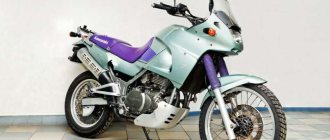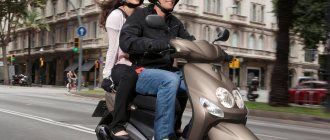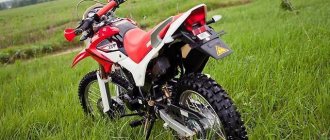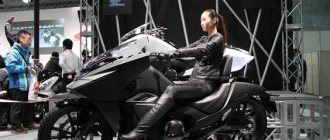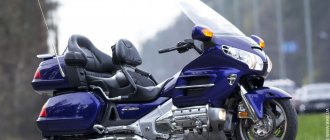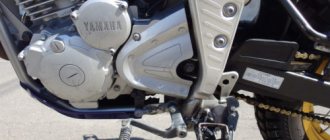There are very, very few universal motorcycles , and one of them is the Yamaha TDM 850. The times when it was produced are long gone, but even almost two decades after the last TDM 850 rolled off the production line, this model is still has been in some demand for some time now. This bike was never intended for the general public, despite its claims to versatility, but it was this quality that helped it acquire an entire army of fans. Even its successor, the slightly more modern TDM 900, was not as loved as the old Yamaha TDM 850, especially the first generation. And there are reasons for this.
The new machine from Yamaha made a splash all over the world.
The new machine from Yamaha made a splash all over the world.
The new machine from Yamaha made a splash all over the world.
The first generation of TDM was released in 1991 and was produced until 1995, and sales of the device began almost simultaneously both in Japan and in Europe and North America. The device was equipped with an in-line twin with five-valve cylinder heads, simultaneous up-down movement of the pistons and alternating stroke. In this sense, the engine resembled a boxer engine familiar to many, where the pistons also move synchronously. The engine at that time was no longer a new product. Since 1989, it has been installed on production XTZ750 Super Tenere and has already won the Paris-Dakar race several times. For the new TDM, the cylinder diameter and piston stroke were increased (from 87x63 to 89.5x67.5), thereby increasing the engine displacement by 100 cm3 and power from 70 hp. at 7200 rpm up to 77 hp. at 7500 rpm. Torque also increased from 68 Nm at 6750 rpm (for the XTZ750) to 75.5 Nm at 6000 rpm. Of course, changes were also made to the transmission. The first two gears were made “shorter”, which ensured more dynamic acceleration, but gears 3–5 were “lengthened” in accordance with the asphalt orientation of the motorcycle.
Two wheels for all occasions
It would seem - what’s so difficult about making a motorcycle that is equally well suited for all purposes? The reasons for this are mainly commercial. Chopper riders do not need a high maximum speed; for fans of sport bikes, dynamics and maneuverability are more important than comfort; long-distance bikers are proud of the unpretentiousness of their touring enduro bikes. The Yamaha TDM 850 partly combines a little bit of everything. The design was original and somewhat controversial, but very successful. The Yamaha TDM 850 was produced for 10 years, having undergone one restyling during this time and receiving a lot of minor improvements.
The Japanese managed to cross a snake with a hedgehog and, with the TDM 850, get a motorcycle that can now be called a crossover. It is not suitable for conquering deserts and swamps, but it can overcome huge distances on broken roads, including dirt roads, with relative comfort and at an affordable price. Now the Yamaha TDM 850 on the secondary market is very cheap, comparable to some 20-year-old “400”. Why not? The maximum speed of the TDM 850 exceeds 200 km/h (but this also depends on the body kit and condition of the motorcycle), the gas tank holds 18-20 liters (depending on the generation), and acceleration from 0 to 100 km/h on a working bike is possible in 3. 8 seconds. Impressive even by modern standards, but the first Yamaha TDM 850 went on sale back in 1991, when the USSR was bursting at the seams and falling apart. At the same time, many copies are still in use, and with proper care they will last for another couple of decades.
Why is the Yamaha TDM 850 so loved? For a large range, excellent maneuverability, a good level of comfort, maintainability and overall endurance. The design of the first generation was quite controversial, many considered it outdated even at the time of its release, but in 1996 the production of the second generation TDM 850 began. The appearance turned out to be successful, and it went almost unchanged to its successor, the TDM 900, which was produced later, in 00s. However, Yamaha still couldn’t manage to make a universal motorcycle with impunity, so there was a fly in the ointment.
The second version of TDM has become smoother on the outside and “V-shaped” on the inside.
The second version of TDM has become smoother on the outside and “V-shaped” on the inside.
The second version of TDM has become smoother on the outside and “V-shaped” on the inside.
This engine is one of the champions in “eating” oil. Even a completely serviceable vehicle can consume up to 200 grams per 1000 km, let alone equipment that is approaching 20 years old! This is due to both the large number of valves and the liner design of the cylinders. Despite its high reliability, the main guarantee of the durability of the CPG is proper running-in, which in most cases neither Japanese nor European riders have even heard of. We also note the rather soft metal of the oil scraper rings, which wear out much faster than compression rings. So if the TDM oil appetite begins to approach “a liter per thousand”, it’s worth considering repairs. Simply replacing the valve stem seals will most likely not give the desired results. Most often, it is the rings that are to blame for increased oil consumption. Unfortunately, it is impossible to buy oil scraper rings separately, and a full set of rings for both pistons will cost about 3,500 rubles. Compression rings should be changed only if they are significantly worn, when the gap in the ring locks exceeds 0.7 mm - and take a closer look at the cylinder.
Pros and cons of the Yamaha TDM 850
Advantages
- Affordable price . Due to its age, you can buy a TDM 850 for a very modest amount of money, although you need to inspect the motorcycle very carefully before purchasing. Nothing lasts forever, and a 25-year-old bike will only remain in good condition if it has been in caring hands for a long time.
- Strong and durable plastic . He survives most falls without consequences, unless, of course, they occur at significant speed.
- Surprisingly good standard light . However, this is relevant mainly for the first generation TDM 850.
- Dynamics . The bike accelerates very quickly even with a load and a passenger.
- Brakes . They are efficient enough for aggressive riding even by modern standards.
- Maneuverability . Thanks to the successful weight distribution, the motorcycle subjectively does not seem heavy, and it is very easy to control.
- Power reserve . The fuel consumption of the TDM 850 when driving at a speed of 130-140 km/h does not exceed 6 liters of AI-92 , and the tank holds from 18 to 20 liters of gasoline.
Flaws
- Engine habit of eating oil . It is necessary to constantly monitor its level.
- Difficulty of maintenance . This is a price to pay for versatility in use, but maintaining the Yamaha TDM 850 is really not easy. So, to replace the spark plugs, you need to drain the antifreeze and dismantle the radiator, and to get to the battery, you have to remove the gas tank and side plastic.
- Bad carburetors . The problem can be treated by replacing it with others from TDM 850 1999-2001.
- Controversial rear brake caliper design. It sometimes jams a little, which leads to accelerated wear of the brake disc and pads.
- Difficulty finding spare parts . It’s difficult to find something more serious than spark plugs or a battery for the TDM 850 in stock even in a large city, so you have to order what you need from Japan and wait for delivery.
200912151933_5
If this is not possible, then you should agree with the seller so that he does not warm up the device before the meeting, and look at the cold start with your own eyes. Black smoke from a newly started engine is a bad sign. By the way, a cold start can also tell you about the motorcycle’s oil appetite. The “push-pull” smell of burnt oil from the pipe should be very alarming. After the engine has warmed up, hold a piece of paper or a napkin to the exhaust pipe and rev it up properly. A spot of black soot on paper is a bad sign, and if individual black splashes are visible, it’s a bad sign.
Specifications
Yamaha TDM 850 technical specifications:
The engine is based on the Yamaha XTZ 750 engine, which is the winner of the Paris-Dakar rally. The ten-valve liquid-cooled twin is modified with hundreds of “cubes”, the motorcycle squeezes out 80 hp. With. and 75 nm of torque.
Transmission. The gearbox is 5-speed, but that's not a problem. The chain drive retains power while transferring the engine's power to the rear wheel, so there's no better transmission. Remember that first and second gears are shorter than the others.
Several motorcycles are replaced by this bike
Chassis and brakes. The bike's wheels are universal: thanks to high-profile tires, the Yamaha TDM 850 is ready to ride on any potholes without the risk of bending them. The brakes of the motorcycle are in good condition and are trouble-free; there is no risk of souring.
Fuel consumption. The engine pulls well, so it consumes a lot of oil, especially if you are a Schumacher. Before a long trip, it is recommended to fill in a couple of liters more, since a TDM engine consumes up to 1.5 liters of oil per thousand kilometers. Nothing bad will happen from overflowing.
Basic equipment and accessories. The built-in lights leave much to be desired, everyone admits this. Treated with xenon, diodes, lens replacement. After 140-150 km/h it starts to blow away, as the wind protection is rather weak. Theoretically, this problem can be solved by installing high glass with a spoiler. Also, protective arches and panniers will not interfere.
200912151933_6
The next point of close attention when inspecting a motorcycle is the gearbox. Of course, you shouldn’t expect perfect clarity and ease of switching from a fairly well-established Yamaha, but the unit should work properly. It is highly advisable to take a ride on the device and click the box. Quite often there is wear on the fork, which is responsible for engaging the second gear, causing “missing” and “popping out”. Over time, the gear that is not engaged (that is, the gear that is not fully engaged) is eaten away and then a complete overhaul of the gearbox is ensured (from 20,000 to 30,000 rubles when replacing the gearbox with a used one with replacement work). So if there is a defect, you should either seriously reduce the price or refuse to purchase altogether.
Reviews from Yamaha TDM 850 owners
In 2014 I bought a TDM850 made in '93 for 120 thousand, the motorcycle was alive, but a little tired. The mileage was 40+ thousand km, but I think this is already the third or fourth round. I drove almost 20 thousand in two years, after which the engine said “boom”. An autopsy showed that one of the previous owners apparently poured sunflower oil into it instead of motor oil, at least, otherwise it is impossible to explain such an amount of dirt. For 25 thousand, a used contract motor from Finland was brought in, replaced, after which the bike was successfully destroyed in an accident on the Moscow Ring Road. I was luckier than the motorcycle, so the next year I bought a TDM 850 again, but this time of the second generation. Subjectively it’s the same, the headlights shine a little worse, the ride is a little better, but the difference is at the level of sensations. Ruslan, Yamaha TDM 850 '1993, Moscow.
An excellent and completely indestructible road bike with tourenduro suspensions. The spare parts are really poor, but the consumables are all suitable from other Yamas, so there are no problems. The actual mileage is unknown, I have already driven about 35,000 km without any serious breakdowns so far. The only problem was the detachment of the loaded trunk from the trunk at a speed of ~180 km/h, fortunately there were no cars behind. But this doesn’t seem to be a problem with the motorcycle, but otherwise everything is fine, for 150-180 thousand this is the only motorcycle suitable for long-distance travel, which can be found. Sergey, Volgograd, Yamaha TDM 850 '2000.
Before buying, I looked at reviews of the TDM 850 on YouTube, read the reviews, and didn’t understand how it could be comfortable on a motorcycle that looks like a typical classic. I myself had driven a Steed 400 before, but I wanted better suspension and a more peppy engine. As a result, I took a proven TDM 850 from a friend, he did not deceive me, I got a well-maintained motorcycle, albeit with external scuffs. Now I’ve finished the 2018 season on it, I don’t plan to sell it, I’ve been driving it for three years already. I tried the TDM 900 - the same thing, I rode the Varadero 1000 - I didn’t understand at all how people drive this iron. Along the way, I will continue to ride my 850 as long as there are spare parts for it. Victor, Odintsovo, Yamaha TDM 850 '1997.
The shock absorber is attached to the pendulum “without progression” and does not cause headaches.
The shock absorber is attached to the pendulum “without progression” and does not cause headaches.
The shock absorber is attached to the pendulum “without progression” and does not cause headaches.
The TDM suspension is simple and reliable; a conventional “telescope” in the front and a monoshock absorber without a linkage system in the rear, as a rule, do not cause any complaints, however, it is worth considering one nuance when disassembling the fork stays. When removing the supporting pipe from the “glass”, the metal guides (sliders) fit into one another and peel off the entire sliding Teflon layer from each other, so that along with the seals (920 rubles), you will have to spend money on guides (1300 rubles per set) . Thus, the current fork seals provide a well-founded reason to reduce the price not only by the cost of its standard rebuild (2500–3000 rubles), but also by the cost of a set of new sliders.
009_moto_0412_050
The design and appearance in the Ducati style, combined with the ease of maintenance of the “Japanese” - this is the Yamaha TRX 850. The design and appearance in the Ducati style, combined with the ease of maintenance of the “Japanese” - this is the Yamaha TRX 850.
| ESTIMATED COST OF CONSUMABLES AND SPARE PARTS | ||
| Name | Original spare parts, rub. | Non-original spare parts, rub. |
| Oil filter | 800 | 250–400 |
| Air filter | 2500 | 1500 |
| Front brake pads | 5200 | 2300–3000 |
| Rear brake pads | 2800 | 1500–1800 |
| Chain and sprockets, set | 18000 | 5500–8000 |
| Brake/clutch levers | 1500 | 500–1000 |
| Frame sliders | — | 3000–5000 |
COMPETITORS.
A “consumed” rear brake disc is a consequence of a soured caliper.
A “consumed” rear brake disc is a consequence of a soured caliper.
A “consumed” rear brake disc is a consequence of a soured caliper.
Another reason for bargaining could be a broken driven star bearing (RUB 1,650) - this unit is subject to wear much more than other wheel bearings. To understand the condition of the unit, just grab the star with your hands and try to swing it in a plane perpendicular to the axis of the wheel. There shouldn't be any play. By the way, it is worth checking the axial play of the star. Its cause is broken damper rubber bands attaching the star hub to the wheel (RUB 770 per set). Replacing them will not take much time - just remove the wheel and remove the sprocket along with the base from the wheel hub.
TDM brakes are a very reliable unit, but sometimes the rear caliper jams due to piston misalignment and the rear brake disc is “eaten up” ahead of time. Replacing a worn disc and rebuilding a caliper can cost 12–15 thousand rubles.
Version 2.0
In 1996, the first-born was replaced by the new TDM. Despite the old name, a lot has changed in the motorcycle. He was completely reborn in appearance, although he retained common “family” features. But as the biker wisdom goes: “The biggest improvement in your bike is never visible from the outside.” Here too, the usual in-line two-cylinder engine suddenly became a V-shaped one. How is this possible? Very simple! The crankshaft journals were rotated 90º, and the engine operation pattern became absolutely identical to the V-shape, because the working strokes no longer occurred at regular intervals. And although the power and torque remained unchanged, using the entire arsenal of power has become more convenient.
The secret to the success of the FZX 750
The Yamaha V-Max 1200 was not very cheap, so they decided to simplify the FZX to reduce its cost. A 20-valve, 4-cylinder liquid-cooled engine was inserted into a tubular steel frame, and the wheel drive was made to be a chain drive, considering that the cardan would make the structure more expensive and heavier. They didn’t think much about the design, having come up with a certain average look for this motorcycle with recognizable features of its “big brother” - V-Max. The square headlight looks archaic, but stylish in its own way - this design element immediately makes the Yamaha FZX stand out in city traffic. It’s a pity that it shines so-so, but what can you expect from light optics developed in the mid-80s of the last century? But the overall silhouette with “chopped” straight lines turned out to be brutal and generally interesting.
The full-power European version accelerates to 100 km/h in 3.2 seconds, and the Japanese version in 4. At the same time, the maximum speed is 220 and 180 km/h, respectively. The weight of the bike is about 225 kg, but it doesn’t seem heavy - the engine located in the frame at an angle shifts the center of gravity down, so subjectively the bike seems quite light. It is not deprived of suspensions - both the front and rear shock absorbers are equipped with pumping, which allows them to be adjusted, in addition, the rear shock absorbers have the standard ability to set the required pretension. Although it must be admitted that the Yamaha FZH 750 accelerates much better than it handles - at high speed the motorcycle turns into a cannonball, which is difficult to force to change its trajectory. Well, what did you want - it’s a dragster! Fortunately, its brakes are passable - 267 mm brake discs all around, with 2-piston calipers (2 discs on the front wheel and 1 on the rear).
In the “first”, the oil tank is installed next to the shock absorber, and the filler neck and screw are located under the saddle.
In the “first”, the oil tank is installed next to the shock absorber, and the filler neck and screw are located under the saddle.
In the “first”, the oil tank is installed next to the shock absorber, and the filler neck and screw are located under the saddle.
In addition, the diameter of the front fork pipes increased to 43 mm (versus 41 for the TDM-1) and the “jamb” with pipe guides disappeared. The oil tank moved from under the seat to the engine crankcase, and the battery moved from under the gas tank to the rear shock absorber area. By the way, although the batteries installed on the first and second generations of TDM are externally similar, they are slightly different. The TDM-1 battery (YTX12BS) is 87mm wide, and the TDM-2 battery (YT12B-BS) is 69mm wide (other dimensions are the same). Thus, it will not be possible to install a battery from the first generation on a second-generation motorcycle - it simply will not fit into the battery compartment. At the same time, reverse replacement is possible. Keep this in mind when purchasing a new battery!
Cost of annual maintenance and spare parts
Spare parts for the Yamaha TDM 850 will not put a big dent in your wallet, as the motorcycle is easy to maintain. In large motorcycle dealerships and spare parts stores, you can most often find all the necessary parts and components. According to the owners of this bike, it does not require significant repairs - only seasonal replacement of consumables and proper maintenance. There is moderate oil burn if you turn it over 6 thousand. In city mode, oil is usually not noticed in the choking.
In the “second”, the oil filler neck is hidden under plastic.
In the “second”, the oil filler neck is hidden under plastic.
In the “second”, the oil filler neck is hidden under plastic.
Unfortunately, the second generation of “Tygdym”, having become more beautiful and more modern in appearance, did not get rid of most of the “diseases” of its predecessor, so all the “problem” areas of the TDM-1 are also the same for the second.
Reboot
In 1999, the “Tedeem Horse” underwent another modernization, and quite a serious one. Without practically changing the appearance of the car, Yamaha launched an essentially new device onto the market. So, on the dashboard, the fuel meter took the place of the coolant temperature sensor, the mechanical odometer gave way to an electronic display, and the speedometer itself, although it remained a pointer, began to be driven not by a cable, but by electronics, from a magnetic sensor in the wheel, an alarm button appeared. The dipstick disappeared from the oil tank, giving way to a cleaner and easier-to-use inspection window, the clutch was strengthened and the gearbox ratios were slightly closer together. Thanks to the new carburetors, the filling of the cylinders with the mixture has improved, and softer settings of the springs and membranes have made it possible to dose the gas more accurately and gently. In addition, a throttle position sensor has appeared, based on the readings of which the engine control unit adjusts the ignition timing, and all this together made it possible to raise the peak torque to 80.4 Nm at 6000 rpm. Of course, the developers also took into account the tendency of old carbs to over-enrich the mixture: the new unit almost does not suffer from this disease. An electric pump is now responsible for filling the carburetors with fuel - instead of the previous vacuum one.
The reason for this was problems with the pump itself. So, after a long stay, the vacuum unit required quite a lot of time to fill the float chambers with gasoline, which often led to problems with starting, and in hot weather the pump located directly above the engine overheated and air pockets formed in it, which, of course, led to interruptions in engine operation. This replacement also made it possible to abandon the archaic gas tap, and a “reserve fuel remaining” lamp appeared on the dashboard. In addition to all these innovations, mirrors and some finishing elements have changed. Thus, of the entire galaxy of “Tygdyms”, the most rational purchase will be a motorcycle of this particular generation, because in addition to the actual age, almost all “childhood diseases” of previous generations have been eliminated.
Review
The Yamaha TRX 850 is equipped with a ten-valve two-cylinder engine with a dry sump, which is a modification of the TDM850 engine. The second generation TDM is similar to the TRX unit in alternating flashes at 270°, but differs in carburetor and camshaft settings. The character inherent in sportbikes is fully manifested in the operation of the engine: power delivery is even and smooth, traction is maintained throughout the entire speed range. Power units are characterized by minimal vibration loading, which is very unusual since the nature of the operation is similar to engines with a 90-degree cylinder camber.
The frame of the Yamaha TRX 850 sports motorcycle is made of steel pipes and is similar in design to Ducati. The original appearance of the frame is not its only advantage: it has excellent rigidity. The sporty nature of the chassis is emphasized by brakes and suspension borrowed from the Yamaha FZR motorcycle range. The rear shock absorber and front fork are equipped with a wide range of settings. The Brembo braking system features 320mm front discs with two four-piston calipers and a rear two-piston caliper.
The motorcycle seat is flat, comfortable and quite spacious, allowing you to change the seating position on long trips by moving the driver back and forth. Hard seat cushions can somewhat spoil long trips, which, however, can be easily fixed by replacing the seat.
The Yamaha TRX 850 was discontinued in 1999. Over all the years of production, it has not undergone any changes.
200912151933_11
The history of the model does not end there: in 2002, the third generation of the device appeared: TDM900. In addition to the volume increased to 897 cm3, the motorcycle acquired a fuel injection system, a sixth gear in the gearbox, an aluminum alloy frame, an ABS system (since 2005) and many other innovations. In fact, this is a completely new device, inheriting from its ancestors only the name, engine layout and ideology. Thanks to the new design, the TDM900 acquired not only unique consumer qualities, but also a number of unique features and disadvantages that are worthy of a separate article.
Similar models
The Yamaha TDM 850 has practically no analogues; this motorcycle was completely unique for its time, and modern two-wheeled crossovers are too different from it and cost completely different money to be able to compare them correctly. The only truly similar bike is the Yamaha TDM 900, which is a modified version of the second generation TDM 850 with fuel injection, a retuned and filed engine and other minor changes. Finding a 900 cc version is not difficult, and almost all the advantages and disadvantages have been transferred to it from its carburetor ancestor. With the exception of oil burns, Japanese designers managed to successfully solve this problem on the TDM 900.
200912151924_3
Like most motorcycles that stand out from the crowd, the TDM is not as popular as, say, four-cylinder classics or sportbikes. However, it is precisely such controversial devices that win the most loyal fans. So, most often TDM is sold only for the purpose of buying another, more recent TDM, or those who, having tried it, are not imbued with the spirit and character of this device. Thanks to the caste isolation of this “reclassic - sub-enduro”, prices for TDM are kept at a fairly low level relative to road vehicles of similar power and cubic capacity, not to mention large enduros. So, for copies of the first years of production (1992–1995) they ask from 110 to 150 thousand rubles. For second-generation devices (1996–1998), which have already been used throughout Russia, they ask from 130 to 180 thousand rubles. and up to 210 if the motorcycle just arrived from Japan or Europe. For the latest modification of the 850 (1999–2001) you will have to pay from 200 to 240 thousand rubles. - a motorcycle devoid of “jambs” is valued noticeably more. And prices for “nine hundred” cars start from 250 thousand rubles. The question of selling a motorcycle in the future is worth thinking about now.
Tuning
Like any other motorcycle, the Yamaha TDM850 can be easily improved. Experienced owners of these bikes are inclined to believe that the windshield needs some modification, since standard glass does not provide reliable protection from headwinds and other not very pleasant moments such as encounters with midges. Don’t forget about panniers - fans of long trips try to equip their motorcycle with this attribute already in the first stages.
Tuning Yamaha TDM850. Left view
Tuning Yamaha TDM850. Right view
Read other motorcycle reviews Review of Suzuki Boulevard M109R
Another tuning option for Yamaha TDM850
When falling, the foot of the gearbox often suffers, so protective arches are a dire necessity.
When falling, the foot of the gearbox often suffers, so protective arches are a dire necessity.
When falling, the foot of the gearbox often suffers, so protective arches are a dire necessity.
We have already noted that, as a rule, people who buy TDM do so consciously and, most often, are already familiar with the motorcycle. Hence the simple conclusion: the better the technical condition of the device and the “fresh” it is, the greater the likelihood of selling it profitably and quickly. Problems can only arise with the sale of a copy of the first series, since their target audience is aspiring Tygdym workers from the class of students and other not very wealthy youth. Of course, sooner or later the motorcycle will find its owner, but even now, at a time when the financial condition of the population is not the best, it is quite difficult to sell a device from the early 90s. So when buying, it is better to opt for the youngest possible specimen.
Photo gallery
Yamaha TDM850 on the go
Yamaha TDM850. Silver
It's worth the money
It's time to take a ride
A motorcycle is like an extension of you
Main competitors
- Honda X4. This bike is a rival firm's attempt to create a rival to the Yamaha FZX 750 and V-Max by using a reworked engine from the Honda CB 1300 Super Four. The bike turned out to be very interesting, but it failed in sales, as a result of which it was quickly discontinued.
- Honda V45 Magna 750. Power cruiser with impressive performance. What it has in common with the Yamaha FZH 750 is the combination of frantic dynamics and mediocre handling, especially at high speed. This especially applies to representatives of the first generation of Honda. Due to its advanced age, finding a Magna in decent condition is no easier than an FZX 750.
Engine
Previously, during the production of the first models, the engine was designed for off-road driving, and not at all on a flat highway. It has become more voluminous, reaching 900 cubic meters, but this is not the limit. It also now has a fuel injection system, the engine has become more manageable at low speeds. The exhaust sound is very similar to the exhaust of a V-twin engine. The response to turning the throttle, according to reviews, has become much smoother, even if the gear was selected incorrectly. There is also a slight vibration, but it does not interfere as much as it did before; even the appearance in the mirrors does not change its quality.
A chain support system was installed, which reduced noise and vibration levels.
The gearbox has also undergone changes, becoming six-speed. Compared to the old version, the initial gear has become more playful, and even in it you can accelerate to hundreds, the remaining gears have become “closer” to each other.
Video
- Review of Yamaha TDM850 and Yamaha TDM900.
- Review and test drive of the Yamaha TDM 850-2 motorcycle (in English).
Motorcycle Yamaha TDM 850
- a kind of half-breed, a compromise hybrid between different classes of motorcycles, which was born in the early 90s as a response to the desire of individual representatives of the motorcycle community to have a truly universal motorcycle. Of course, there is no real universality and cannot be, you cannot be perfect in everything at once, but Yamaha decided to try to make its new bike as good as possible. The success turned out to be unambiguous - even in the USA, where traditionally motorcycles with an unclear scope of application have traditionally not enjoyed huge success, sales went well. The TDM 850 has become what is now sometimes, by analogy with the world of cars, called a crossover.
Yes, although this motorcycle is not perfect, it can be called truly universal. It is capable of taking a corner with ease, easily weaving through city traffic jams, and carrying a motorcyclist with a load for many thousands of kilometers, while arrogantly not giving a damn about the quality of the road surface. True, such versatility had to be paid for by the complexity of the design. For example, to get to the Yamaha TDM 850 battery, you need to remove the side plastic and gas tank from the motorcycle, and to replace the spark plugs you need to remove the cooling radiator.
The TDM 850 engine traces its origins to the Yamaha XTZ 750 engine, winner of the Paris-Dakar rally. For the TDM 850, this in-line ten-valve liquid-cooled twin was slightly modified and a hundred “cubes” were added to it, squeezing eighty horsepower and 75 nm of torque out of the motorcycle. The transmission inherited from the Super Tenere was also modified, making the first two gears shorter and the rest longer. The engine turned out to be successful, extremely high-torque, but characterized by an oily appetite, especially at high speed. However, since the oil in the Yamaha TDM 850 splashes in the oil tank, from where it is taken by the oil pump, many owners of this motorcycle simply fill in a couple of liters more before traveling. There is no threat to the motorcycle from such an overflow.
The maximum speed of the TDM 850 lies somewhere around 220 km/h, however, oil consumption at this speed is already quite noticeable. But the Yamaha maintains a cruising speed of 150-160 km/h easily, without irritating the motorcyclist with vibrations and consuming gasoline moderately. In addition, the bike is really well adapted to bad roads. Of course, it cannot be called enduro - no, the TDM 850 is designed for asphalt. It may be bad, broken into rubbish, but still asphalt. However, if you put the motorcycle on all-purpose tires instead of purely road tires, it will ride more than confidently on the ground.
The height of the saddle is quite noticeable; a person with a height of 180 cm can reach his legs confidently, but a shorter biker may not find it very comfortable. The laconic instrument panel is hidden built into the front fairing, and the steering wheel is located very conveniently. There is also plenty of space for the passenger, and if you install side and central panniers on the Yamaha TDM 850, he can easily take a hundred liters of cargo on the road.
The first version of this motorcycle, externally distinguished by two round headlights, was produced from 1991 to 1995. In 1995, modernization was carried out, in addition, the motorcycle acquired a different appearance, with which it was produced for another decade and a half, already under the name Yamaha TDM 900, which replaced the 850 cc version at the turn of the millennium. And we must admit that Japanese engineers have created a real masterpiece. Yes, the TDM 850 has its weak points, and it is sometimes difficult to maintain it yourself, but it is a truly universal motorcycle for all occasions, and, according to owners, it is distinguished by excellent reliability.
Tire selection
No matter how hard Yamaha tries to position the TDM and Tracer as "rogues", this will not stop them from being road motorcycles and needing road tires. Look in the sport-touring sections. Good options would be Dunlop Roadsmart - III, Metzeler Roadtec 01, Michelin Pilot Road 3 or 4, Pirelli Angel ST or GT, Conti Road Attack 2.
If the spirit of adventure doesn’t stop itching, then for the Tracer you can find tires that are a little toothier, like they put on the assembly line for touring enduros: Conti Trail Attack 2, Metzeler Tourance Next, Pirelli Scorpion Trail 2, or even a completely toothy off-road type like Conti Twinduro TKC 80 The last one is already extreme, but the remaining options will be extremely useful for travel routes towards the east and southeast of Moscow, where dirt on the roads and sand dunes creeping onto them are a normal occurrence.
With an 18” TDM front wheel everything is more complicated.
Nothing is produced by anyone in the world, but there is still one trick. You can install a 110/80–18 Pirelli MT 60 Corsa (shout out to the Ducati Scrambler, for which this wheel was created), which has good grip on asphalt and average grip off it, and in the standard size 160/60–17 the rear of the same is matched to it the model itself. And this is the only option, all other front wheels, even in size 110/80–18, will turn out to be rear wheels and with a speed index intended for SUVs with a volume of 150–225 cubic meters, for whom they were produced. For TDM, the speed index needs V (240) or W (270), in the most extreme case H (210), and then only with reservations. The motorcycle is fast and not the lightest. www.motorezina.ru So that the suit... does not fade > May 23, 2017 12:32 Mikhail Pimus


